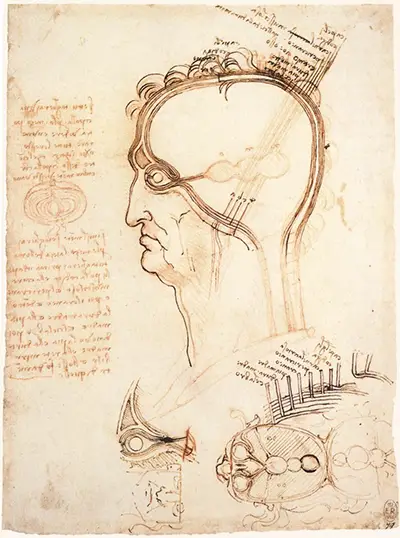A perfect embodiment of Leonardo da Vinci’s prowess and ingenuity in anatomy is a 1489 drawing that has incessantly been referred to as The Comparison of Scalp skin and Onion.
This Early Renaissance Art was drawn in 1489 in Milan, Italy by Leonardo da Vinci using chalk, ink and paper.
The drawing was made on a paper with the dimensions measuring 152 by 203 mm or 5.9 by 7.9 inches.
This masterpiece was a sketch of the anatomy of the human brain that sought to enunciate the structure of the layers of the human scalp by comparing it to an onion.
Leonardo da Vinci is undoubtedly one of the most outstanding and remarkable personalities that lived during the Renaissance period.
This is because he not only graced the world with some of the finest pieces of artwork that have been universally applauded but also due to his multifaceted proficiency in myriad fields.
This comparison is premised on the fact that the onion and the human scalp have several striking similarities.
A key similarity that inspired Leonardo da Vinci to sketch this portrait was the fact that comparably with the Onion which when cut down the centre exposes a series of coatings that form circles throughout the onion, the human scalp is also made up of a series of coatings which includes the hair, the skin, muscular flesh and the cranium.
In this respect, the Comparison of Scalp Skin and Onion seems to be one of the most pertinent analyses of the anatomy of the head in the realm of neurology.
This drawing has quite a salient illustration on the left hand side. The image depicts a series of membranous coverings that enclose the brain known as meninges. The meninges are vital in the brain as they play the indispensable role of supporting the vessels that supply blood to the brain.
The meninges also contain the cerebrospinal fluid. Leonardo da Vinci intuitively compares this layer with the succulent layers of an onion with which it is structurally similar.
Like most of Leonardo da Vinci’s artistic works, the Comparison of Scalp Skin and Onion is a drawing that is widely extolled in today’s modernity and has consequently been put in the public domain.
This thrilling piece can been found in a myriad of places including its country of origin, Milan, Italy, and The Royal Library in the Windsor Castle, United Kingdom.
Leonardo da Vinci shall forever be adjudged positively by history due to his industriousness and exceptional advancements that he made during the Renaissance.
As a matter of fact, most of his works such as the 1489 Comparison of Scalp Skin and Onion are some of the factors that defined the Renaissance and made it the incredibly transformative epoch that it was.
Most importantly, the Comparison of Scalp Skin and Onion is definitely a major framework within which the modern neurology is established and the advancements that ensued thereafter can be attributed to this this shrewd art.


